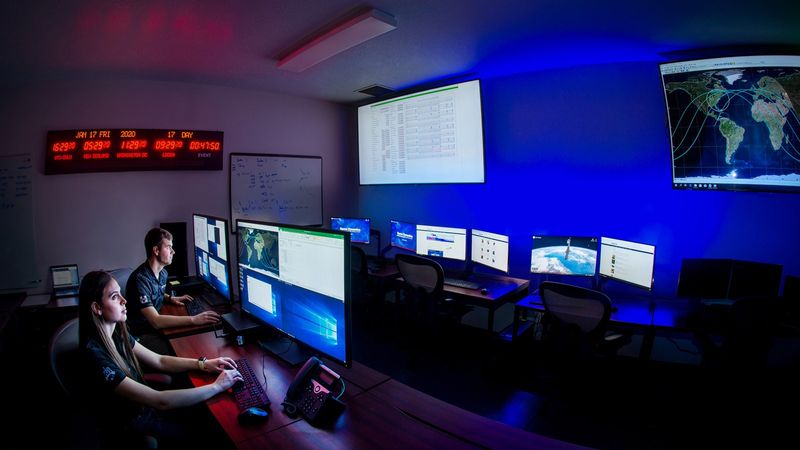
Space Dynamics Laboratory small satellite operators are shown in this January 17, 2020 photo at the controls of one of SDL's Mission Operations Centers. (Credit: Space Dynamics Laboratory/Allison Bills).
Utah State University’s Space Dynamics Laboratory announced that a small satellite built by SDL was successfully deployed into orbit, and early telemetry indicates that the spacecraft health is nominal and the satellite is operating as designed.
On November 2, 2019, a Northrop Grumman Antares rocket carrying the SDL-built Hyper-Angular Rainbow Polarimeter CubeSat, known as HARP, in its Cygnus cargo spacecraft launched from Virginia Space’s Mid-Atlantic Regional Spaceport at NASA’s Wallops Flight Facility. Following a three-month stay on the International Space Station, HARP was deployed into its intended orbit on February 19.
Measuring approximately 10 centimeters wide, 10 centimeters high, and 30 centimeters long, the HARP satellite was built by SDL to carry the HARP payload built by the University of Maryland, Baltimore County. Miniature spacecraft of this size are often classified as CubeSats.
“We are honored to be part of this important mission, led by principal investigator J. Vanderlei Martins from UMBC, that will enable scientists to better understand aerosol and cloud processes in our atmosphere,” said SDL’s HARP program manager Tim Neilsen. “The ground-breaking advances provided by Dr. Martins and his team enable valuable atmospheric measurements to be made by a much smaller package than previously possible. We are grateful for the partnership with UMBC and NASA’s Earth Science Technology Office on HARP, and look forward to a successful mission on orbit.”
Cloud and aerosol processes influence weather variation, which affects our oceans, ecosystems, and society at large. The largest impediment to estimating weather variation is a lack of quantitative information about aerosols and particulates in the atmosphere. Scientists require new observations and a better understanding of aerosol and cloud processes to narrow weather variation estimate uncertainties.
The objective of HARP is to validate the in-flight capabilities of a highly accurate and precise wide field of view hyper-angular polarimeter for characterizing aerosol and cloud properties. Additionally, HARP will demonstrate that CubeSat-size technology can provide science-quality multi-angle imaging data, paving the way for lower-cost aerosol-cloud instrument development.
“Since the start of mission planning, and throughout HARP’s life cycle, including system engineering and design, fabrication, and rigorous testing of the CubeSat, the dedicated engineers, scientists, technicians, and business professionals at SDL have remained committed to ensuring the success of HARP,” said Asal Naseri, SDL’s small satellite technologies branch head. “SDL is now ‘flying’ HARP and monitoring its health while it is in a low-Earth orbit from one of our small satellite Mission Operation Centers. The telemetry indicates that spacecraft health is nominal and the satellite is performing as designed.”
Once satellites are placed into their intended orbits, operational work continues throughout their lifespan to ensure mission success. Monitoring the health of spacecraft, delivering commands to conduct orbital maneuvers, and performing other operational requirements are all accomplished through mission operation centers. Large satellites, sometimes the size of a school bus, often dominate the resources needed to operate smaller satellites. However, with the increased use and utility of small satellites, dedicated mission operation centers like those at SDL are becoming more common.
The Space Dynamics Laboratory has been solving the technical challenges faced by the military, science community, and industry for six decades and supports NASA’s vision to reveal the unknown for the benefit of humankind. As one of fourteen University Affiliated Research Centers, SDL serves as a subject matter expert in its core research areas to the US Government and ensures that essential engineering and technology capabilities of the Department of Defense are maintained. SDL is a DoD research laboratory headquartered in North Logan, UT, and has offices in Albuquerque, NM; Bedford, MA; Dayton, OH; Huntsville, AL; Houston, TX; Los Angeles, CA; Stafford, VA; and Washington, DC. For more information, visit www.sdl.usu.edu.
Contact
- SDL Public Relations
- 435-713-3054
- pr@sdl.usu.edu